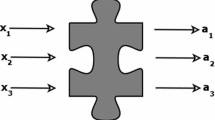Abstract
This article is concerned with the conceptual background of information mechanics (IM) and some of the consequences of axiomatization of IM, and touches on some examples as to instances in which IM might seem to have offered, within a single conceptual picture, interesting approaches to some questions which have variously been regarded as quite different. In IM, representation of information in physical systems is treated as a conceptual, computation, and design tool. Some examples touched on are an IM approximate relation among,h, c, m e, G, and ∼α; particle masses and mass-charge relation; cosmological red shift without assuming that distant light sources are rapidly receding; gravity; and knowability of prediction. IM is then used as a tool for looking into making information processing “hardware” out of “software”, with information representations formed within extended region(s) of nearly homogeneous “medium(s)”.
Similar content being viewed by others
References
Cohen, E. R., and Du Mond, J. W. M., (1965).Reviews of Modern Physics,37, 537–594.
Cohen, E. R., and Taylor, B. N. (1973). “The 1973 Least-Squares Adjustment of the Fundamental Constants,”Journal of Physical and Chemical Reference Data,2(4), 663–734.
Kantor, Frederick W., (1977)Information Mechanics. Wiley, New York [pp. v and 1–3, and (except as to use of square brackets) Subsection 1.1, thereof are incorporated herein by reference].
Kantor, Frederick W., (1981). Second International Conference on Precision Measurement and Fundamental Constants (PMFC-II), U.S. National Bureau of Standards (1981 June 7–12).
Taylor, B. N., Parker, W. H., and Langenberg, D. N. (1969). “Determination ofe/h, QED, and the Fundamental Constants,”Reviews of Modern Physics,41, 375.
Author information
Authors and Affiliations
Additional information
All or part of this material may be or become the subject of U.S. or foreign patents pending or issued. Inclusion of any material herein shall not be construed as implying any license under any patent.
Rights and permissions
About this article
Cite this article
Kantor, F.W. An informal partial overview of information mechanics. Int J Theor Phys 21, 525–535 (1982). https://doi.org/10.1007/BF02650182
Received:
Issue Date:
DOI: https://doi.org/10.1007/BF02650182




